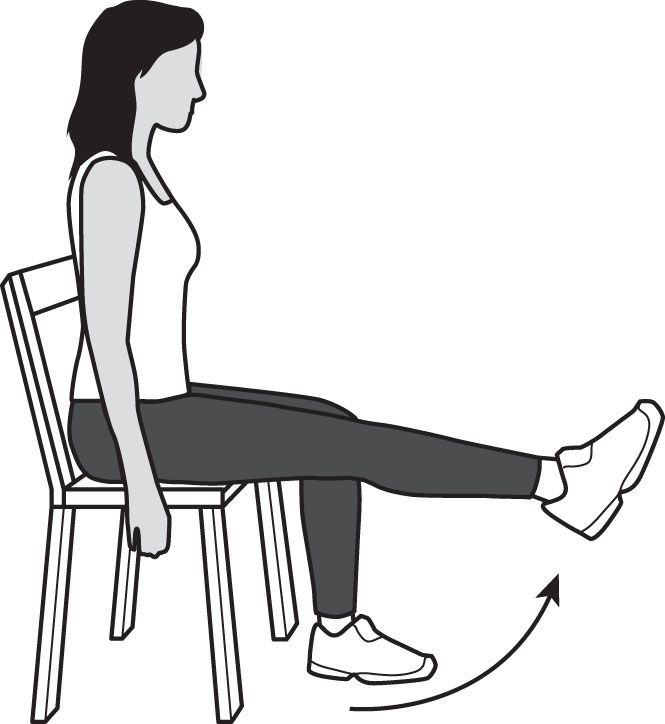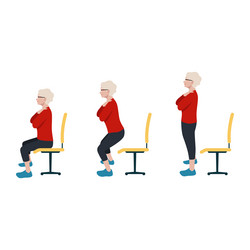The knee joint is particularly susceptible to arthritis due to its weight-bearing nature and constant use. As arthritis progresses, the cartilage in the knee joint may become damaged, resulting in bone-on-bone contact and increased pain.
Exercing the knee and the area around the knee can build supporting muscles that take pressure off the area, as well as reducing stiffness and increasing mobility. It's important not to put too much pressure on the joints and avoid types of exercise that will make it worse.
Now, not all of these exercises will be suitable for everyone, although we have modified some of them to be less taxing forms of the traditional examples, meaning that we've accounted for balance issues and other stiff body parts.
It's important to approach exercising with arthritis carefully, and if something hurts too much or you're having difficulty don't worry and try a different exercise. You can of course modify these exercises to be more taxing as well with the addition of medicine balls and weights, however, this would only be recommended for mild issues.
Benefits of Exercise for Knee Arthritis
Engaging in regular exercise offers numerous benefits for individuals with arthritis. Some of the key advantages include:
- Pain relief: Exercise helps reduce joint pain by promoting the release of endorphins, the body's natural painkillers.
- Improved joint flexibility: Regular exercise increases the range of motion in the joints, making everyday tasks easier.
- Stronger muscles: Strengthening the muscles around the joints provides added support and stability, reducing the strain on the affected areas.
- Weight management: Maintaining a healthy weight is crucial for individuals with arthritis, as excess weight puts additional stress on the joints. Exercise, combined with a balanced diet, can help achieve and maintain a healthy weight.
- Enhanced mood and mental well-being: Exercise releases feel-good hormones and reduces stress, anxiety, and depression commonly associated with chronic pain conditions.
Importance of Good Form For Knee Exercises
Maintaining good form during knee exercises is essential to prevent injury and maximize benefits. Pay close attention to your body alignment, posture, and the range of motion in your joints. If you experience any pain or discomfort during an exercise, stop immediately and consult with a healthcare professional.
Safety Precautions
When performing knee exercises, it's important to take certain safety precautions to avoid further injury. These include:
- Using supportive footwear
- Choosing a flat, stable surface for exercise
- Avoiding exercises that cause excessive pain or discomfort
- Gradually increasing the intensity and duration of exercises over time
Range of Motion Exercises for Knee Arthritis
Range of motion exercises help improve the flexibility and mobility of the knee joint. These exercises promote the full movement of the knee, reducing stiffness and increasing joint function. Here are some effective range of motion exercises for arthritis of the knee:
Knee Flexion and Extension

Knee flexion and extension exercises involve bending and straightening the knee joint. Here's how to perform this exercise:
- Sit on a chair with your feet flat on the floor.
- Slowly extend your affected leg out in front of you, keeping your knee straight.
- Hold the extended position for a few seconds, then slowly bend your knee to bring your foot back towards you.
- Repeat this movement 10-15 times, gradually increasing the number of repetitions over time.
Ankle Pumps

Ankle pumps help improve blood circulation in the legs and prevent blood clots. This exercise also helps maintain ankle mobility, but also stretches several of the knees supporting tendons. Follow these steps to perform ankle pumps:
- Sit on a chair and extend your legs in front of you.
- Slowly flex your ankles, bringing your toes towards your body.
- Hold the flexed position for a few seconds, then point your toes away from your body.
- Repeat this movement 10-15 times, gradually increasing the number of repetitions over time.
Heel Slides

Heel slides are beneficial for increasing knee joint mobility and improving quadriceps strength. Here's how to perform this exercise:
- Lie on your back with your legs extended.
- Slowly bend your affected knee, sliding your heel towards your buttocks.
- Hold the bent position for a few seconds, then slowly straighten your leg to return to the starting position.
- Repeat this movement 10-15 times, gradually increasing the number of repetitions over time.
Strengthening Exercises for Arthritic Knees
Strengthening exercises help build muscle strength and stability around the knee joint, reducing the strain on the affected area. Strong muscles provide better support and protection for the knees. Incorporate the following exercises into your routine to strengthen the muscles around your knees:
Straight Leg Raises

Straight leg raises target the quadriceps muscles, which play a vital role in knee stability. Follow these steps to perform straight leg raises:
- Lie on your back with one leg extended and the other knee bent.
- Slowly lift your extended leg off the ground, keeping it straight.
- Hold the lifted position for a few seconds, then lower your leg back down.
- Repeat this movement 10-15 times on each leg, gradually increasing the number of repetitions over time.
Quadriceps Contractions
Quadriceps contractions are isometric exercises that strengthen the quadriceps muscles without moving the knee joint. Here's how to perform quadriceps contractions:
- Sit on a chair with your feet flat on the floor.
- Tighten the muscles on the front of your thigh (quadriceps) by pushing your knee down into the chair.
- Hold the contraction for a few seconds, then release.
- Repeat this movement 10-15 times, gradually increasing the duration of the contractions over time.
When doing this you should see your thigh flex when pressing downwards.
Hamstring Curls
Hamstring curls target the hamstring muscles at the back of the thigh, we'll wnat to modify them and you'll need a mat for this. Here's how to perform hamstring curls:
- Lay face down on a flat surface.
- Slowly bend one knee, bringing your heel towards your buttocks.
- Hold the bent position for a few seconds, then lower your foot back down.
- Repeat this movement 10-15 times on each leg, gradually increasing the number of repetitions over time.
Balance and Stability Exercises
Balance and stability exercises are crucial for individuals with arthritis as they help improve proprioception and reduce the risk of falls. These exercises focus on enhancing the body's ability to maintain balance and stability during daily activities. Incorporate the following balance and stability exercises into your routine:
Single-Leg Stance
The single-leg stance exercise helps improve balance and stability. Make sure you do it next to something you can hold onto if needed. Here's how to perform it:
- Stand upright with your feet hip-width apart.
- Slowly lift one foot off the ground and balance on the other leg.
- Hold the position for as long as you can, aiming for 30 seconds.
- Repeat on the other leg, gradually increasing the duration of the stance over time.
Heel-to-Toe Walk
The heel-to-toe walk exercise helps improve balance and coordination. Follow these steps to perform it:
- Stand upright with your feet together and arms by your sides.
- Take a step forward, placing your heel directly in front of your toes on the opposite foot.
- Continue walking in a straight line, placing each foot in front of the other in a heel-to-toe pattern.
- Aim to walk for 10-15 steps, gradually increasing the distance over time.
Sit Stands
This one is as simple as it sounds, you're going to get up and down from a chair repeatedly.

- Sit in an upright posture on a straight backed chair
- Stand up
- Come to a completely straight stance
- Repeat for 10-30 times as necessary
There are also other things that can be done to manage stiffness, such as avoiding inflammatory foods, anti inflammation supplements, topical creams. The latter can be particularly useful when trying to increase mobility when combined with an exercise regemin.
Always remember to discuss work out plans with your healthcare provider, although it is worth noting that sometimes family doctors can err on the side of caution with these sort of issues, particularly when it comes to older patients, remember you know your limits and it is often worth talking to a dedicated physio if possible.




